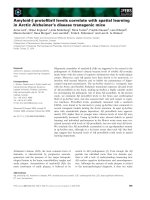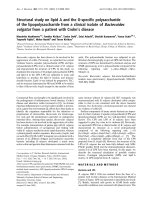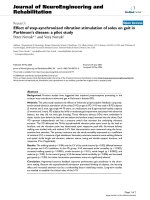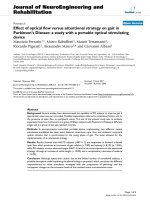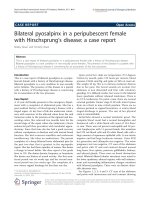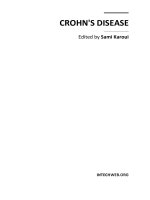Infliximab therapy in pediatric Crohn’s disease: a review docx
Bạn đang xem bản rút gọn của tài liệu. Xem và tải ngay bản đầy đủ của tài liệu tại đây (217.35 KB, 7 trang )
© 2010 Parashette et al, publisher and licensee Dove Medical Press Ltd. This is an Open Access article
which permits unrestricted noncommercial use, provided the original work is properly cited.
Clinical and Experimental Gastroenterology 2010:3 57–63
Clinical and Experimental Gastroenterology Dovepress
submit your manuscript | www.dovepress.com
Dovepress
57
REVIEW
open access to scientific and medical research
Open Access Full Text Article
6451
Iniximab therapy in pediatric Crohn’s disease:
a review
Kalyan Ray Parashette
1
Raghavendra Charan
Makam
2
Carmen Cuffari
3
1
Department of Pediatrics, University
of Illinois at Chicago, Chicago,
IL, USA;
2
Department of Internal
Medicine, Berkshire Medical Center,
Pittsfield, MA, USA;
3
Division of
Pediatric Gastroenterology,
The Johns Hopkins Children’s
Center, Baltimore, MD, USA
Correspondence: Carmen Cuffari
The Johns Hopkins School of Medicine,
Division of Pediatric Gastroenterology,
600N Wolfe St, Brady 320, Baltimore,
MD, USA
Abstract: Anti-tumor necrosis factor alpha (TNF-α) therapy has re-defined our treatment
paradigms in managing patients with Crohn’s disease (CD) and ulcerative colitis. Although
the ACCENT studies showed proven efficacy in the induction and maintenance of disease
remission in adult patients with moderate to severe CD, the pediatric experience was
instrumental in bringing forth the notion of “top-down” therapy to improve overall clinical
response while reducing the risk of complications resulting from long-standing active
disease. Infliximab has proven efficacy in the induction and maintenance of disease remission
in children and adolescents with CD. In an open-labeled study of 112 pediatric patients
with moderate to severe CD, 58% achieved clinical remission on induction of infliximab
(5 mg/kg) therapy. Among those patients who achieved disease remission, 56% maintained
disease remission on maintenance (5 mg/kg every 8 weeks) therapy. Longitudinal follow-up
studies have also shown that responsiveness to infliximab therapy also correlates well with
reduced rates of hospitalization, and surgery for complication of long-standing active disease,
including stricture and fistulae formation. Moreover, these children have also been shown
to improve overall growth while maintaining an effective disease remission. The pediatric
experience has been instructive in suggesting that the early introduction of anti-TNF-α therapy
may perhaps alter the natural history of CD in children, an observation that has stimulated a
great deal of interest among gastroenterologists who care for adult patients with CD.
Keywords: Crohn’s disease, infliximab, pediatric
Introduction
Crohn’s disease (CD) and ulcerative colitis are chronic inflammatory intestinal
disorders affecting 1.7 million people in North America.
1
Recent studies have shown
an increasing incidence of CD in children, and an overall prevalence of 10% to 25%
of all patients with inflammatory bowel disease (IBD).
2,3
CD is characterized by patchy
transmural inflammation involving any segment of the gastrointestinal tract from
the mouth to the anus. Patients will typically show recurrent clinical exacerbations
marked by symptoms of abdominal pain, diarrhea, and rectal bleeding, alternating with
episodes of quiescent disease. Children often manifest constitutional signs of weight
loss, growth failure and pubertal delay that may in part be secondary to extensive
proximal small bowel disease of increased severity. Moreover, pediatric CD is often
associated with extra intestinal manifestations, including arthritis, episcleritis, uveitis
and erythema nodosum.
1
Although the principal goal of therapy is to induce and maintain an effective disease
remission, the intestinal mucosa will often show ongoing inflammation that contributes
Number of times this article has been viewed
This article was published in the following Dove Press journal:
Clinical and Experimental Gastroenterology
11 June 2010
Clinical and Experimental Gastroenterology 2010:3
submit your manuscript | www.dovepress.com
Dovepress
Dovepress
58
Parashette et al
to frequent relapses and less than favorable maintenance of
clinical remission. Since CD may progress from intestinal
inflammation to strictures and penetrating disease, including
fistulas and abscess formation, mucosal healing has become
a primary treatment objective. Since delayed puberty and
growth failure is seen in 15% to 40% of pediatric patients
with CD,
4
achieving normal growth and development also
represents an important end-point to therapy. The ultimate
goal is to achieve and sustain an effective disease remission
that avoids complications associated with long-standing and
unremitting disease. To achieve this clinical objective is of
paramount importance in order to improve patient quality
of life, and avoid psychological complications, including
anxiety, and depression. Given the myriad of potential
therapies available to treat patients with CD, it has become
increasingly important to select those medications with the
most favorable benefit risk ratio that will minimize the overall
need for corticosteroids (Figure 1).
Non-biological therapy
Enteral nutrition has proven efficacy in inducing disease
remission in children with active CD,
5
as well as preventing
disease relapse in 60% to 75% of patients within a year.
6,7
Although enteral nutrition is effective in inducing disease
remission and in reversing micronutrient deficiencies, these
treatment formulas are unpalatable and often require naso-
gastric or gastrostomy tube placement. Typically, adolescent
patients are non-adherent to the prolonged implementation
of nutritional therapy. They often object to the placement of
these feeding tubes or the exclusivity of enteral nutritional
therapy during periods of quiescent disease.
5–7
Thomsen and coworkers showed in a double blind
multicenter study of 182 adults with CD that mesalamine was
able to induce remission in 45%, 42% and 36% of patients
with mild to moderate disease at the end of 8 weeks, 12 weeks
and 16 weeks, respectively.
8
However, de Franchis and
coworkers showed that once patients achieved disease
remission on mesalamine, less than 50% of patients were able
to sustain disease remission after one year of maintenance
therapy.
9
Although studies have shown that corticosteroids are
effective in inducing remission in patients with active CD,
10
not all patients respond favorably. And among those patients
that respond to induction corticosteroids, 40% to 68% of
patients will relapse within a year, while up to 36% of patients
will develop corticosteroid dependency.
11–14
This observation
is also underscored by the detrimental impact of long-term
corticosteroid use on patient growth and development.
Immunosuppressant drugs, including methotrexate, aza-
thioprine (AZA, and 6-mercaptopurine (6-MP) are all effec-
tive in maintain disease remission in 40% to 65% of patients
with corticosteroid-dependent moderate to severe CD.
15–18
Biological therapy
In comparison, the biological agents used in CD include:
the anti-tumor necrosis factor alpha (TNF-α) agents
infliximab, adalimumab and certolizumab pegol (Figure 2)
and anti-adhesion molecule drugs. All of these biological
agents have been shown to be effective in children with CD.
Herein, our focus will be on the role of infliximab in treating
pediatric CD.
TNF-α
Over the last several years, our understanding of the
pathogenesis of CD has improved remarkably with the
development of several animal models. Indeed, the pro-
inflammatory cytokine TNF-α is known to play an important
role in CD,
19
and has led to the development of several
novel treatment strategies, including infliximab. TNF-α
can transmit signals between immune cells leading to
inflammation, thrombosis and fibrinolysis. Various stimuli,
including bacterial endotoxin, radiation and viral antigens
can bring on the release of secretory TNF-α from monocytes,
macrophages and T-cell lymphocytes. As a potent pro-
inflammatory cytokine, TNF-α must be firmly regulated;
and failure to do so, allows for an unmediated inflammatory
response.
20
In patients with CD, TNF-α is highly localized to
the intestinal mucosa and lumen. Indeed, high concentrations
have been measured in the lamina propria of the bowel of
patients with CD
21
and increased concentration of TNF has
also been found in the stool of children with CD.
22
At the
Mild to moderate
disease
Moderate to severe
disease
Antibiotics
5-ASA
Surgery
Infliximab
MTX
AZA/6-MP
systemic
corticosteroids
MTX = methotrexate
AZA = azathioprine
6-MP = 6-mercaptopurine
5-ASA = 5-aminosalicylic acid
Budesonide
Figure 1 Crohn’s disease practice guideline: pharmacologic pyramid.
Clinical and Experimental Gastroenterology 2010:3
submit your manuscript | www.dovepress.com
Dovepress
Dovepress
59
Iniximab for pediatric Crohn’s
level of the mucosa, TNF-α recruits circulating inflammatory
cells to the intestinal tissue, inducing tissue edema, coagula-
tion activation through thrombin activation and granuloma
formation. The migration of neutrophils is further facilitated
through the increased expression of adhesion molecules and
IL-8 by endothelial cells. TNF-α is pivotal in the formation
of granulomas, one of the histological hallmarks of CD.
Through its up-regulation of monocyte chemo-attractant
protein-1, monocytes are recruited into the site of gra-
mulomatous inflammation. CD4 T-cell lymphocytes are
the probable source for TNF-α production, as well as other
cytokines involved in the so-called TH1 response, including
interferon-α at the site of granulomas.
Iniximab
Infliximab is a chimeric IgG-1 monoclonal antibody with
a high specificity for TNF-α. It induces apoptosis of TNF-
producing cells, and promotes antibody dependent and
complement dependent cytotoxicity.
23–25
It has been shown
to decrease histologic and endoscopic disease activity
and in inducing and maintaining remission in patients
with active CD. ACCENT I was a multicenter random-
ized double-blind international trial studying retreatment
and remission maintenance in adult patients with CD
treated with infliximab. Patients in this study were divided
into 3 groups: patients given a single 5 mg/kg infusion,
patients given 5 mg/kg every 8 weeks, and patients given
10 mg/kg every 8 weeks for maintenance of remission.
After 54 weeks, the initial clinical response was maintained
in only 17% of patients in the single dose group compared
to 43% of patients maintained on 5 mg/kg every 8 weeks
and 53% of patients maintained on 10 mg/kg every 8 weeks.
In addition, successful steroid-tapering was seen in only
9% of patients in the single dose group compared to 28%
in the 5 mg/kg every 8 weeks group, and 32% of patients
in the 10 mg/kg every 8 weeks group.
26
It has been the practice in many institutions, including
our own to initiate maintenance anti-TNF-α therapy in
patients that have shown clear refractoriness to either long-
term 6-MP or AZA therapy. All of the studies, including
ACCENT, CHARM and PRECISE have not shown any
potential role of combining anti-TNF-α with anti-metabolite
therapy. Moreover, the increasing concern of hepatic T-cell
lymphoma has led many physicians to consider discontinu-
ing either 6-MP or AZA with the introduction of biological
therapy.
27
Although all anti-TNFα therapies have antigenic
properties, those patients on infliximab therapy are most vul-
nerable. The concurrent use of immunosuppressive therapy
has in the past been shown by Rutgeerts and coworkers
to maintain a favorable clinical response to maintenance
infliximab therapy, presumably due to the prevention of
human anti-chimeric antibody (HACA) antibody formation.
Chimeric
monoclonal
antibody
Human
monoclonal
antibody
Humanized
Fab’ fragment
Fc
IgG1
VL
Cκ
VH
CH1
PEG PEG
Infliximab
mAb
Adalimumab
mAb
Certolizumab
pegol
Mouse Human
Figure 2 Anti-TNF-α structure of 3 biological therapies to treat Crohn’s disease.
Clinical and Experimental Gastroenterology 2010:3
submit your manuscript | www.dovepress.com
Dovepress
Dovepress
60
Parashette et al
In that study, 75% (12/16) of patients on concurrent 6-MP
maintained a favorable clinical response, compared to 50%
(9/18) on no concurrent immunosuppressive therapy.
28
In
the ACCENT 1 study, only 18% of the patients on neither
concurrent prednisone nor immunosuppressive drug therapy
developed HACA, compared to just 10% of patients on
concurrent azathioprine or methotrexate therapy.
26
The
therapeutic benefit of concurrent immunosuppressive therapy
is generally considered marginal and is felt to not outweigh
the associated increased risk of hepatic T-cell lymphomas, a
malignancy that is universally lethal in the pediatric patient
population.
27
Moreover, both adalimumab and certolizumab
have proven efficacy in salvaging those patients who develop
either a partial responsiveness or intolerance to infliximab
therapy.
28
As a result, the purported benefit is not felt to
outweigh the increased risk for malignancy.
Other drug safety issues with infliximab include the devel-
opment of anti-neutrophil antibodies and anti-double stranded
DNA in 34% and 56% of patients on maintenance infliximab
therapy, respectively. Furthermore, the long-term risk in devel-
oping systemic lupus is unknown, and may have an increased
bearing on the African-American population. Other noteworthy
long-term safety issues include the risk of super-infection (32%)
and the risk of tuberculosis.
11
Adalimumab
The immunogenicity of infliximab has led to the development
of other less immunogenic TNF inhibitory agents, including
adalimumab and certolizumab. Adalimumab (fully human
anti-TNF) has recently received approval for the treatment
of active CD. Several studies have shown adalimimab to be
superior to placebo for inducing and maintaining remission.
It has also been shown to spare corticosteroids and salvage
those patients with CD recalcitrant to infliximab therapy with
an excellent safety profile. Unlike infliximab, adalimumab
is prescribed as a subcutaneous injection every 2 weeks as a
maintenance therapy.
28,29
Iniximab use in children
Studies evaluating the safety and efficacy of infliximab
in children were first reported in several non-randomized
studies.
30–34
These initial studies showed that the response and
remission rates (both partial and complete) were far superior
compared to conventional therapy. Interestingly, its efficacy
in children appeared to be higher than in adult.
31,32
In a multicenter, open-label, dose-blinded trial (n = 21),
Baldassano and coworkers demonstrated the efficacy and
safety of a single infusion of infliximab in the treatment of
pediatric CD. During the 12-week duration of the study,
100% achieved a clinical response and 48% achieved clinical
remission, with significant improvements in the pediatric CD
activity index (PCDAI), modified CDAI, erythrocyte sedi-
mentation rate, and other outcome variables of interest. There
were no infusion reactions in any of the patients and it was
suggested that infliximab may be safe and effective as short-
term therapy of medically refractory moderate to severe CD.
35
A prospective study published by Cezard and coworkers also
explored the efficacy and toxicity of infliximab in children
with severe CD. Twenty-one children (median age 15, range
13 to 17) were treated with infliximab with an induction
sequence of 5 mg/kg at 0, 15, and 45 days. Nineteen children
were in complete remission (defined as Harvey-Bradshaw
index (HBI) ,4) on day 45. 14/21 patients had stopped taking
steroids at 3 months, and all had stopped parenteral nutrition.
All perianal fistulas (n = 12) were also closed by day 90 and
the drug appeared to be well tolerated.
36
Much evidence at present comes from retrospective
analysis of children treated with infliximab, often as a
rescue medication. In a retrospective study in children and
adolescents with either corticosteroid dependent or resistant
CD, patients were randomized to receive 1 to 3 infusions of
infliximab (5 mg/kg/dose) over a 12-week period. The mean
daily prednisone dosages decreased significantly in all the
patients (P , 0.01) studied. A significant initial improvement
(as assessed by a significant decline in PCDAI value) was
noted in all subjects (P , 0.0001). Interestingly, over the
subsequent 8-week period, 8 of 19 treated subjects had wors-
ening of symptoms.
37
Lamireau and coworkers described yet
another retrospective study in 88 children and adolescents
(median age: 14, range: 3.3 to 17.9) treated with infliximab
for active disease (66%) and/or fistulas (42%) that were
refractory to corticosteroids (70%), and/or other immuno-
suppressive (82%) agents, and/or parenteral nutrition (20%).
Patients received a median of 4 (1 to 17) infusions of 5 mg/kg
of infliximab during a median time period of 4 months (1 to
17 months). From day 0 to day 90, the Harvey-Bradshaw
score decreased from 7.5 to 2.8 (P , 0.001), with a significant
decrease in both C-reactive protein and ESR (P , 0.001). At
day 90 after the first infusion of infliximab, 49% of patients
had symptom improvement, 29% were in remission; 53% of
patients could be weaned off of corticosteroids and 92% off
of parenteral nutrition.
38
The authors in both these studies
concluded that treatment with infliximab was well tolerated
and effective in most children and adolescents with CD
refractory to conventional immunosuppressive therapy. No
serious events were noted in any of these studies.
Clinical and Experimental Gastroenterology 2010:3
submit your manuscript | www.dovepress.com
Dovepress
Dovepress
61
Iniximab for pediatric Crohn’s
The Food and Drug Administration (FDA) approval for
the use of infliximab therapy in pediatric CD was based on
the results of the much publicized REACH clinical study,
a randomized, multicenter, open-label study to evaluate
the safety and efficacy of anti-TNF-α antibody in pediatric
subjects with moderate to severe CD. A total of 112 pedi-
atric patients (ages 6 to 17 years) with moderate to severe
CD who took part in this study received infliximab at
5 mg/kg at week 0, 2 and 6. Patients who showed symptom
improvement, or response, were then randomized to 2 groups
and received infliximab every 8 or 12 weeks for almost 1 year.
A concurrent immunomodulator was also required. At week
10, 88% patients showed response (defined as decrease from
baseline in the PCDAI score $15 points; total score #30)
and 58% patients achieved clinical remission (defined as
PCDAI score #10 points). At week 54, 63% and 56%
patients receiving infliximab every 8 weeks were in clinical
response and clinical remission, respectively, compared with
33% and 23% patients receiving treatment every 12 weeks
(P = 0.002 and P , 0.001, respectively). The data from this
important prospective trial thus suggested that infliximab
is not only highly effective in inducing clinical response
and remission but also in maintenance of remission, more
so with an 8-week dosing compared with every 12-week
dosing.
39
The same research consortium also found infliximab
to be an effective therapy in children with perianal disease,
including patients with perianal fistula,
40
and in prolonging
the withdrawal of corticosteroids over a 3-year follow-up
period.
41
Similar observations have also been made in an
European study in children with CD. In that study, children
on an on-demand treatment schedule were more-likely to
experience a relapse (92%) when compared to patients on
2-month infusion schedule (23%).
42
Immunogenicity
HACA is the common side effect of infliximab infusion.
The antibody is as a result of murine component of chimeric
infliximab. However, adalimumab a fully human anti-TNF-α
drug also has similar side-effects. In the REACH study,
2.9% (3 patients) developed HACA when compared to 35%
on other trials.
39,43–45
This could be explained by patients in
the REACH study receiving concurrent immunosuppres-
sive medication. Seventy-seven percent of patients in the
REACH had inconclusive HACA results. HACA causes
infusion reactions (acute and delayed), shortened response
and also loss of response. Risk factors for development of
HACA are single and episodic infusion, female gender, long
gap between first and second infusion, and previous infusion
reaction. Studies suggest that it can me minimized by giving
maintained therapy, a concomitant immunosuppressive
agent, and corticosteroid.
44,45
Acute infusion reaction occurs in 11% to 8% patients
and at 2.5% to 5.3% per infusion depending on the dosing
method and concomitant treatment.
39,46–48
Patients develop
pruritus, chest pain, nausea, headache, and flushing within
24 hours. Antihistamines and/or corticosteroids do not
prevent the infusion reaction. However, infusion reaction can
be controlled by slow infusion, along with administration of
antihistamine and corticosteroids. It is our general practice to
pre-medicate those patients susceptible to infliximab-induced
infusion reactions with hydrocortisone therapy.
48
Delayed infusion reaction is very rare (0.7% to 3%).
Patients presents after 4 to 9 days with back pain, myalgia,
arthralgia, and skin rash.
46,47
It is seen after the second or
third infusion dose and usually responds to corticosteroid
therapy.
Infliximab therapies often induce formation of anti
nuclear antibody and anti double standard antibody.
49
However these antibodies are not of any clinical significance
as studies suggest that no pediatric patients have developed
drug-induced systemic lupus or organ damage.
Infections
Infliximab causes decreased levels of polymorph nuclear
cells and T-cell lymphocytes specifically at mucosal site.
This results in increased risk of infectious with bacteria,
virus and fungi. Active infection is a contraindication for
infliximab use. Also, live vaccines are contraindicated as
there is an increase risk of serious infection. Every patient
has to undergo a screening test for tuberculosis, as multiple
studies suggest reactivation of latent tuberculosis.
50,51
The risk of infection is 3.8% to 8% and the upper
respiratory tract is commonly affected.
26,52
In the REACH
study, the incidence rate of upper respiratory tract infection
was 35.8% and 32.0% in patients receiving infliximab every
8 weeks and every 12 weeks, respectively.
39
Overall infection
rate was high (73.6%) among the first group patients than
the later group (38.0%). But serious infection occurred at
the same rate in both the groups (5.7% to 8%). In a study
of adult patients with CD, Colombel and coworkers treated
500 patients with infliximab, 41 (8.2%) of whom developed
infection. Among these 41 patients, 15 had serious infection
(2 fatal sepsis, 8 pneumonia, 1 severe viral gastroenteritis,
2 abdominal abscess, 1 arm cellulitis, 1 histoplasmosis).
53
Other studies also suggest the occurrence of Listeria
monocytogenes meningitis, cutaneous Tinea, shingles, and
Clinical and Experimental Gastroenterology 2010:3
submit your manuscript | www.dovepress.com
Dovepress
Dovepress
62
Parashette et al
herpes zoster.
45,54
One report also suggests reactivation of
hepatitis B in 3 patients diagnosed with chronic hepatitis B
on treatment with infliximab.
55
Malignancy
In a prospective study of 20 patients, 28% developed
reactivation of Epstein-Barr virus (EBV). However, EBV
PCR level returned to normal after 6 months of discontinuing
infliximab.
56
In a study of 6290 adult patients on maintenance
infliximab therapy, there was no increased risk of malignancy
in the infliximab group compared to patients on conventional
therapy.
57
In a multi-center matched-pair trial, the incidence
rate of malignancy was 2.2% (9 patients) in the CD group
and 1.7% (7 patients) in the non-CD group after a follow-
up of 4.5 years.
58
Meena and coworkers first reported a case
of hepatosplenic T-cell lymphoma in a 17-year-old female
CD patient treated with infliximab and 6-MP.
27
Nine more
cases of hepatic T-cell lymphoma have been reported in IBD
patients treated with infliximab and 6-MP/AZA.
59
However
there is no case report of an IBD patient developing hepatic
T-cell lymphoma on infliximab alone.
Summary
The arsenal of biological therapies is increasing. A large
multi-centered pediatric study is now investigating the use
of adalimumab in children with CD. Furthermore, the FDA
approval of certolizumab, a novel pegylated anti-TNF therapy,
is expected soon. The pediatrician will soon be faced with
the dilemma of which medications to use, in either the more
traditional step-up or top-down approach. Indeed, there is a
growing tendency to consider biological drugs in lieu of more
traditional therapies, as discussed above. While genotype–
phenotype correlations may allow clinicians to predict certain
more aggressive forms of CD, future studies are still needed
to provide an evidenced-based approach to drug therapy.
Disclosures
Dr Cuffari is a consultant for, and receives research support
from, UCB, the manufacturer of certolizumab.
References
1. Cuffari C. Inflammatory bowel disease in children: A pediatrician’s
perspective. Minerva Pediatr. 2006;58(2):139–157.
2. Kugathasan S, Judd RH, Hoffmann RG, et al. Epidemiologic and clinical
characteristics of children with newly diagnosed inflammatory bowel
disease in wisconsin: A statewide population-based study. J Pediatr.
2003;143(4):525–531.
3. Hildebrand H, Finkel Y, Grahnquist L, et al. Changing pattern of
paediatric inflammatory bowel disease in northern stockholm 1990–2001.
Gut. 2003;52(10):1432–1434.
4. Griffiths AM, Nguyen P, Smith C, et al. Growth and clinical course of
children with crohn’s disease. Gut. 1993;34(7):939–943.
5. Hiwatashi N. Enteral nutrition for crohn’s disease in Japan. Dis Colon
Rectum. 1997;40(10 Suppl):S48–S53.
6. Griffiths AM, Ohlsson A, Sherman PM, et al. Meta-analysis of
enteral nutrition as a primary treatment of active crohn’s disease.
Gastroenterology. 1995;108(4):1056–1067.
7. Gonzalez-Huix F, de Leon R, Fernandez-Banares F, et al. Polymeric
enteral diets as primary treatment of active crohn’s disease: A
prospective steroid controlled trial. Gut. 1993;34(6):778–782.
8. Thomsen OO, Cortot A, Jewell D, et al. A comparison of budesonide
and mesalamine for active crohn’s disease. international budesonide-
mesalamine study group. N Engl J Med. 1998;339(6):370–374.
9. de Franchis R, Omodei P, Ranzi T, et al. Controlled trial of oral 5-amin-
osalicylic acid for the prevention of early relapse in crohn’s disease.
Aliment Pharmacol Ther. 1997;11(5):845–852.
10. Levine A, Weizman Z, Broide E, et al. A comparison of budesonide
and prednisone for the treatment of active pediatric crohn disease.
J Pediatr Gastroenterol Nutr. 2003;36(2):248–252.
11. Munkholm P, Langholz E, Davidsen M, et al. Frequency of glucocor-
ticoid resistance and dependency in crohn’s disease. Gut. 1994;35(3):
360–362.
12. Greenberg GR, Feagan BG, Martin F, et al. Oral budesonide for active
crohn’s disease. canadian inflammatory bowel disease study group.
N Engl J Med. 1994;331(13):836–841.
13. Rutgeerts P, Lofberg R, Malchow H, et al. A comparison of budesonide
with prednisolone for active crohn’s disease. N Engl J Med. 1994;
331(13):842–845.
14. Campieri M, Ferguson A, Doe W, et al. Oral budesonide is as effective
as oral prednisolone in active crohn’s disease. the global budesonide
study group. Gut. 1997;41(2):209–214.
15. Candy S, Wright J, Gerber M, et al. A controlled double blind study of
azathioprine in the management of crohn’s disease. Gut. 1995;37(5):
674–678.
16. Markowitz J, Grancher K, Kohn N, et al. A multicenter trial of 6-mer-
captopurine and prednisone in children with newly diagnosed crohn’s
disease. Gastroenterology. 2000;119(4):895–902.
17. Feagan BG, Rochon J, Fedorak RN, et al. Methotrexate for the treatment
of crohn’s disease. the north american crohn’s study group investigators.
N Engl J Med. 1995;332(5):292–297.
18. Feagan BG, Fedorak RN, Irvine EJ, et al. A comparison of methotrexate
with placebo for the maintenance of remission in crohn’s disease. north
american crohn’s study group investigators. N Engl J Med. 2000;
342(22):1627–1632.
19. Bell SJ, Kamm MA. Review article: The clinical role of anti-TNFalpha
antibody treatment in crohn’s disease. Aliment Pharmacol Ther. 2000;
14(5):501–514.
20. Reinecker HC, Steffen M, Witthoeft T, et al. Enhanced secretion of
tumour necrosis factor-alpha, IL-6, and IL-1 beta by isolated lamina
propria mononuclear cells from patients with ulcerative colitis and
crohn’s disease. Clin Exp Immunol. 1993;94(1):174–181.
21. Nicholls S, Stephens S, Braegger CP, et al. Cytokines in stools of chil-
dren with inflammatory bowel disease or infective diarrhoea. J Clin
Pathol. 1993;46(8):757–760.
22. Cornillie F, Shealy D, D’Haens G, et al. Infliximab induces potent
anti-inflammatory and local immunomodulatory activity but no
systemic immune suppression in patients with crohn’s disease. Aliment
Pharmacol Ther. 2001;15(4):463–473.
23. Lugering A, Schmidt M, Lugering N, et al. Infliximab induces apopto-
sis in monocytes from patients with chronic active crohn’s disease by
using a caspase-dependent pathway. Gastroenterology. 2001;121(5):
1145–1157.
24. ten Hove T, van Montfrans C, Peppelenbosch MP, et al. Infliximab
treatment induces apoptosis of lamina propria T lymphocytes in crohn’s
disease. Gut. 2002;50(2):206–211.
25. Scallon BJ, Moore MA, Trinh H, et al. Chimeric anti-TNF-alpha
monoclonal antibody cA2 binds recombinant transmembrane TNF-
alpha and activates immune effector functions. Cytokine. 1995;7(3):
251–259.
Clinical and Experimental Gastroenterology
Publish your work in this journal
Submit your manuscript here: />Clinical and Experimental Gastroenterology is an international, peer-
reviewed, open access journal, publishing all aspects of gastroenterology
in the clinic and laboratory, including: Pathology, pathophysiology
of gastrointestinal disease; Investigation and treatment of gastointes-
tinal disease; Pharmacology of drugs used in the alimentary tract;
Immunology/genetics/genomics related to gastrointestinal disease.
This journal is indexed on CAS. The manuscript management system
is completely online and includes a very quick and fair peer-review
system. Visit to read real
quotes from published authors.
Clinical and Experimental Gastroenterology 2010:3
submit your manuscript | www.dovepress.com
Dovepress
Dovepress
Dovepress
63
Iniximab for pediatric Crohn’s
26. Hanauer SB, Feagan BG, Lichtenstein GR, et al. Maintenance infliximab
for Crohn’s disease: the ACCENT I randomized trial. Lancet. 2002;
359:1541–1549.
27. Thayu M, Markowitz JE, Mamula P, et al. Hepatosplenic T-cell
lymphoma in an adolescent patient after immunomodulator and biologic
therapy for crohn disease. J Pediatr Gastroenterol Nutr. 2005;40(2):
220–222.
28. Colombel JF, Sandborn WJ, Rutgeerts P, et al. Adalimumab for
maintenance of clinical response and remission in patients with Crohn’s
disease: the CHARM study. Gastroenterology. 2007;132:52–55.
29. Rutgeerts P, D’Haens G, Targan S, et al. Efficacy and safety of
retreatment with anti-tumor necrosis factor antibody to maintain
remission in Crohn’s disease. Gastroenterology. 1999;117:761–769.
30. Kugathasan S, Werlin SL, Martinez A, et al. Prolonged duration of
response to infliximab in early but not late pediatric crohn’s disease.
Am J Gastroenterol. 2000;95(11):3189–3194.
31. Lionetti P, Bronzini F, Salvestrini C, et al. Response to infliximab
is related to disease duration in paediatric crohn’s disease. Aliment
Pharmacol Ther. 2003;18(4):425–431.
32. Borrelli O, Bascietto C, Viola F, et al. Infliximab heals intestinal
inflammatory lesions and restores growth in children with crohn’s
disease. Dig Liver Dis. 2004;36(5):342–347.
33. Veres G, Baldassano RN, Mamula P. Infliximab therapy in children
and adolescents with inflammatory bowel disease. Drugs. 2007;67(12):
1703–1723.
34. de Ridder L, Benninga MA, Taminiau JA, et al. Infliximab use in
children and adolescents with inflammatory bowel disease. J Pediatr
Gastroenterol Nutr. 2007;45(1):3–14.
35. Baldassano R, Braegger CP, Escher JC, et al. Infliximab (REMI-
CADE) therapy in the treatment of pediatric crohn’s disease. Am J
Gastroenterol. 2003;98(4):833–838.
36. Cezard JP, Nouaili N, Talbotec C, et al. A prospective study of the
efficacy and tolerance of a chimeric antibody to tumor necrosis factors
(remicade) in severe pediatric crohn disease. J Pediatr Gastroenterol
Nutr. 2003;36(5):632–636.
37. Hyams JS, Markowitz J, Wyllie R. Use of infliximab in the treatment
of crohn’s disease in children and adolescents. J Pediatr. 2000;137(2):
192–196.
38. Lamireau T, Cezard JP, Dabadie A, et al. Efficacy and tolerance of
infliximab in children and adolescents with crohn’s disease. Inflamm
Bowel Dis. 2004;10(6):745–750.
39. Hyams J, Crandall W, Kugathasan S, et al. Induction and maintenance
infliximab therapy for the treatment of moderate-to-severe Crohn’s
disease in children. Gastroenterology. 2007;132(3):863–873.
40. Crandall W, Hyams J, Kugathasan S, et al. Infliximab therapy in children
with concurrent perianal Crohn disease: observation from REACH.
J Pediatr Gastroenterol Nutr. 2009;49:183–190.
41. Ruemmele FM, Lachaux A, Cezard JP, et al. Efficacy of infliximab in
pediatric Crohn’s disease: a randomized multi-center open-label trial
comparing schedule to on demand maintenance therapy. Inflamm Bowel
Dis. 2009;15:388–394.
42. Hyams JS, Lerer T, Griffiths A, et al. Long-term outcome of maintenance
infliximab therapy in children with Crohn’s disease. Inflamm Bowel Dis.
2009;15:816–822.
43. Candon S, Mosca A, Ruemmele F, et al. Clinical and biological
consequences of immunization to infliximab in pediatric crohn’s disease.
Clin Immunol. 2006;118(1):11–19.
44. Miele E, Markowitz JE, Mamula P, et al. Human antichimeric antibody
in children and young adults with inflammatory bowel disease receiving
infliximab. J Pediatr Gastroenterol Nutr. 2004;38(5):502–508.
45. Baert F, Noman M, Vermeire S, et al. Influence of immunogenicity on
the long-term efficacy of infliximab in crohn’s disease. N Engl J Med.
2003;348(7):601–608.
46. Friesen CA, Calabro C, Christenson K, et al. Safety of infliximab
treatment in pediatric patients with inflammatory bowel disease.
J Pediatr Gastroenterol Nutr. 2004;39(3):265–269.
47. Crandall WV, Mackner LM. Infusion reactions to infliximab in children
and adolescents: Frequency, outcome and a predictive model. Aliment
Pharmacol Ther. 2003;17(1):75–84.
48. Jacobstein DA, Markowitz JE, Kirschner BS, et al. Premedication and
infusion reactions with infliximab: Results from a pediatric inflammatory
bowel disease consortium. Inflamm Bowel Dis. 2005;11(5):442–446.
49. Vermeire S, Noman M, Van Assche G, et al. Autoimmunity associated
with anti-tumor necrosis factor alpha treatment in crohn‘s disease:
A prospective cohort study. Gastroenterology. 2003;125(1):32–39.
50. Myers A, Clark J, Foster H. Tuberculosis and treatment with infliximab.
N Engl J Med. 2002;346(8):623–626.
51. Keane J, Gershon S, Wise RP, et al. Tuberculosis associated with
infliximab, a tumor necrosis factor alpha-neutralizing agent. N Engl J
Med. 2001;345(15):1098–1104.
52. Veres G, Baldassano RN, Mamula P. Infliximab therapy in children
and adolescents with inflammatory bowel disease. Drugs. 2007;67(12):
1703–1723.
53. Colombel JF, Loftus EV Jr, Tremaine WJ, et al. The safety profile of
infliximab in patients with crohn’s disease: The mayo clinic experience
in 500 patients. Gastroenterology. 2004;126(1):19–31.
54. Kamath BM, Mamula P, Baldassano RN, et al. Listeria meningitis
after treatment with infliximab. J Pediatr Gastroenterol Nutr. 2002;
34(4):410–412.
55. Esteve M, Saro C, Gonzalez-Huix F, et al. Chronic hepatitis B reactiva-
tion following infliximab therapy in crohn’s disease patients: Need for
primary prophylaxis. Gut. 2004;53(9):1363–1365.
56. Cezard JP, Nouaili N, Talbotec C, et al. A prospective study of the
efficacy and tolerance of a chimeric antibody to tumor necrosis factors
(remicade) in severe pediatric crohn disease. J Pediatr Gastroenterol
Nutr. 2003;36(5):632–636.
57. Lichtenstein GR, Feagan BG, Cohen RD, et al. Serious infections and
mortality in association with therapies for crohn‘s disease: TREAT
registry. Clin Gastroenterol Hepatol. 2006;4(5):621–630.
58. Biancone L, Orlando A, Kohn A, et al. Infliximab and newly diagnosed
neoplasia in crohn’s disease: A multicentre matched pair study. Gut.
2006;55(2):228–233.
59. Mackey AC, Green L, Liang LC, et al. Hepatosplenic T cell lymphoma
associated with infliximab use in young patients treated for inflammatory
bowel disease. J Pediatr Gastroenterol Nutr. 2007;44(2):265–267.




